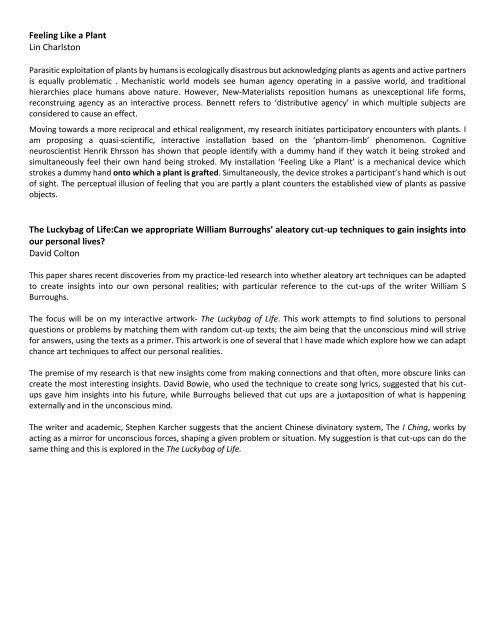Conference Programme FULL (1)
You also want an ePaper? Increase the reach of your titles
YUMPU automatically turns print PDFs into web optimized ePapers that Google loves.
Feeling Like a Plant<br />
Lin Charlston<br />
Parasitic exploitation of plants by humans is ecologically disastrous but acknowledging plants as agents and active partners<br />
is equally problematic . Mechanistic world models see human agency operating in a passive world, and traditional<br />
hierarchies place humans above nature. However, New-Materialists reposition humans as unexceptional life forms,<br />
reconstruing agency as an interactive process. Bennett refers to ‘distributive agency’ in which multiple subjects are<br />
considered to cause an effect.<br />
Moving towards a more reciprocal and ethical realignment, my research initiates participatory encounters with plants. I<br />
am proposing a quasi-scientific, interactive installation based on the ‘phantom-limb’ phenomenon. Cognitive<br />
neuroscientist Henrik Ehrsson has shown that people identify with a dummy hand if they watch it being stroked and<br />
simultaneously feel their own hand being stroked. My installation ‘Feeling Like a Plant’ is a mechanical device which<br />
strokes a dummy hand onto which a plant is grafted. Simultaneously, the device strokes a participant’s hand which is out<br />
of sight. The perceptual illusion of feeling that you are partly a plant counters the established view of plants as passive<br />
objects.<br />
The Luckybag of Life:Can we appropriate William Burroughs’ aleatory cut-up techniques to gain insights into<br />
our personal lives?<br />
David Colton<br />
This paper shares recent discoveries from my practice-led research into whether aleatory art techniques can be adapted<br />
to create insights into our own personal realities; with particular reference to the cut-ups of the writer William S<br />
Burroughs.<br />
The focus will be on my interactive artwork- The Luckybag of Life. This work attempts to find solutions to personal<br />
questions or problems by matching them with random cut-up texts; the aim being that the unconscious mind will strive<br />
for answers, using the texts as a primer. This artwork is one of several that I have made which explore how we can adapt<br />
chance art techniques to affect our personal realities.<br />
The premise of my research is that new insights come from making connections and that often, more obscure links can<br />
create the most interesting insights. David Bowie, who used the technique to create song lyrics, suggested that his cutups<br />
gave him insights into his future, while Burroughs believed that cut ups are a juxtaposition of what is happening<br />
externally and in the unconscious mind.<br />
The writer and academic, Stephen Karcher suggests that the ancient Chinese divinatory system, The I Ching, works by<br />
acting as a mirror for unconscious forces, shaping a given problem or situation. My suggestion is that cut-ups can do the<br />
same thing and this is explored in the The Luckybag of Life.


